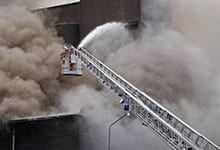In what is being reported as an estimated $60,000 worth of damage, a fire destroyed a residential unit and left soot and water damage in much of the 16th floor of fire origin at the “Century 21” building in Hamilton, Ontario.
Firefighters believe the source may have been a lit cigarette, but it is not clear, and when significant damage occurs from a fire in a building, it is all but impossible to precisely identify the source.
It has not been reported whether or not the fire alarm system, fire sprinkler system, or smoke control system activated during the fire. However, because the vast majority of the fire damage was limited to a single unit, the demising walls inside the building where, in all likelihood at least 1-hour rated, per building code requirements, and maintained in good condition. Meaning, there were likely few holes or unsealed penetrations along the residential walls.
The structure is 43 stories in height. When a fire breaks out in a building this tall, there is always immediate additional cause for concern, from a fire protection engineering standpoint, for a variety of reasons. First, flames and heat travel upward, allowing for the potential for floors above to become involved in the fire. Second, taller buildings have higher total occupant loads, meaning more people are potentially in danger of being affected by the fire or smoke byproduct. Finally, taller buildings create logistical hardships for firefighters. Fire water pressure losses can be significant in tall structures, and firefighters may be required to travel many floors to reach the fire inside stairwells. Estimating 30 seconds per floor for a firefighter in full gear, it would take 22 minutes to travel to the top of a 43 story building.




